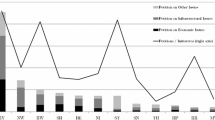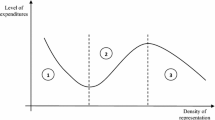Abstract
This paper examines the impact of three measures of direct citizen influence — the initiative, referendum, and recall — on the level of local public expenditure for a national sample of communities with 10,000 persons or more. Two types of statistical tests are performed to analyze the role of the median voter model and to measure the effect of these governmental characteristics on the level of public spending.
Like earlier literature, this paper finds only modest effects of these structural characteristics on local government expenditure. Alternative methodologies are needed to explore the ambiguities which exist in many of the previous studies.
Similar content being viewed by others
References
Abrams, B.A. and Dougan, W.R. (1986). The effects of constitutional restraints on governmental spending. Public Choice 49 (2): 101–116.
Bergstrom, T.C. and Goodman, R.P. (1973). Private demands for public goods. American Economic Review 63 (June): 280–296.
Borcherding, T.E. and Deacon, R.T. (1972). The Demand for services of non-federal governments. American Economic Review 62 (December): 891–901.
Boyne, G.A. (1987). Median voters, political systems and public policies: An empirical test. Public Choice 53 (3): 201–219.
Brennan, G. and Buchanan, J.M. (1980). The power to tax: Analytical foundations of a fiscal constitution. Cambridge: Cambridge University Press.
Brueckner, J.K. (1982). A test for allocative efficiency in the local public sector. Journal of Public Economics 19: 311–331.
Cornwell, E.E. (1985). Comments on the Denzau and Maser papers. Public Choice 47 (1): 219–229.
Deller, S.C. and Chicoine, D.L. (1988). Representative versus direct democracy. A Tiebout test of relative performance: Comment. Public Choice 56 (1): 69–72.
Farnham, P.G. (1986). The impact of government functional responsibility on local expenditure. Urban Affairs Quarterly 22 (September): 151–165.
Farnham, P.G. (1987). Form of government and the median voter. Social Science Quarterly 68 (September): 569–582.
Gonzalez, R.A. and Mehay, S.L. (1985). Bureaucracy and the divisibility of local public output. Public Choice 45 (1): 89–101.
International City Management Association. (1976–1982). The municipal yearbook. Washington, DC: International City Management Association.
Kmenta, J. (1971). Elements of econometrics. New York: Macmillan.
Liebert, R. (1974). Municipal functions, structure and expenditures: A re-analysis of recent research. Social Science Quarterly 54 (March): 765–783.
Megdal, S.B. (1983). The determination of local public expenditures and the principal and agent relation: A case study. Public Choice 40 (1): 71–87.
Pindyck, R.S. and Rubinfeld, D.L. (1976). Econometric models and economic forecasts. New York: McGraw-Hill Book Company.
Pommerehne, W.W. (1978). Institutional approaches to public expenditure: Empirical evidence from Swiss municipalities. Journal of Public Economics 9 (April): 255–280.
Pommerehne, W.W. and Frey, B.S. (1976). Two approaches to estimating public expenditures. Public Finance Quarterly 4 (October): 395–407.
Pommerehne, W.W. and Schneider, F. (1978). Fiscal illusion, political institutions, and local public spending. Kyklos 31: 381–408.
Santerre, R.E. (1986). Representative versus direct democracy: A Tiebout test of relative performance. Public Choice 48 (1): 55–63.
Author information
Authors and Affiliations
Additional information
Research in this article was partially funded by a grant from the Research Program Committee, College of Business Administration, Georgia State University.
Rights and permissions
About this article
Cite this article
Farnham, P.G. The impact of citizen influence on local government expenditure. Public Choice 64, 201–212 (1990). https://doi.org/10.1007/BF00124366
Issue Date:
DOI: https://doi.org/10.1007/BF00124366




